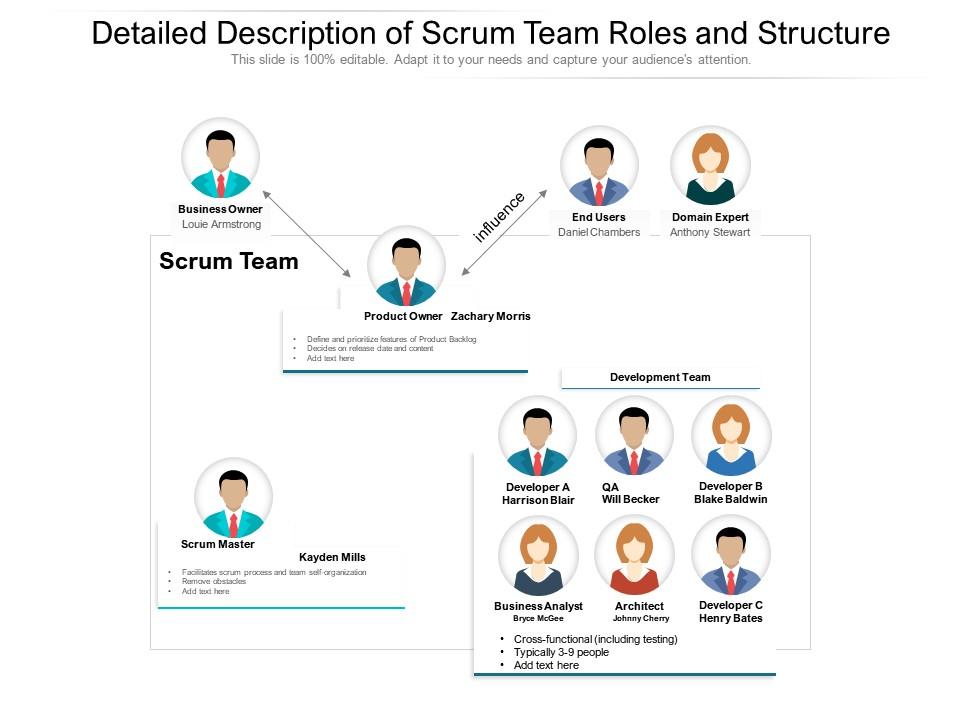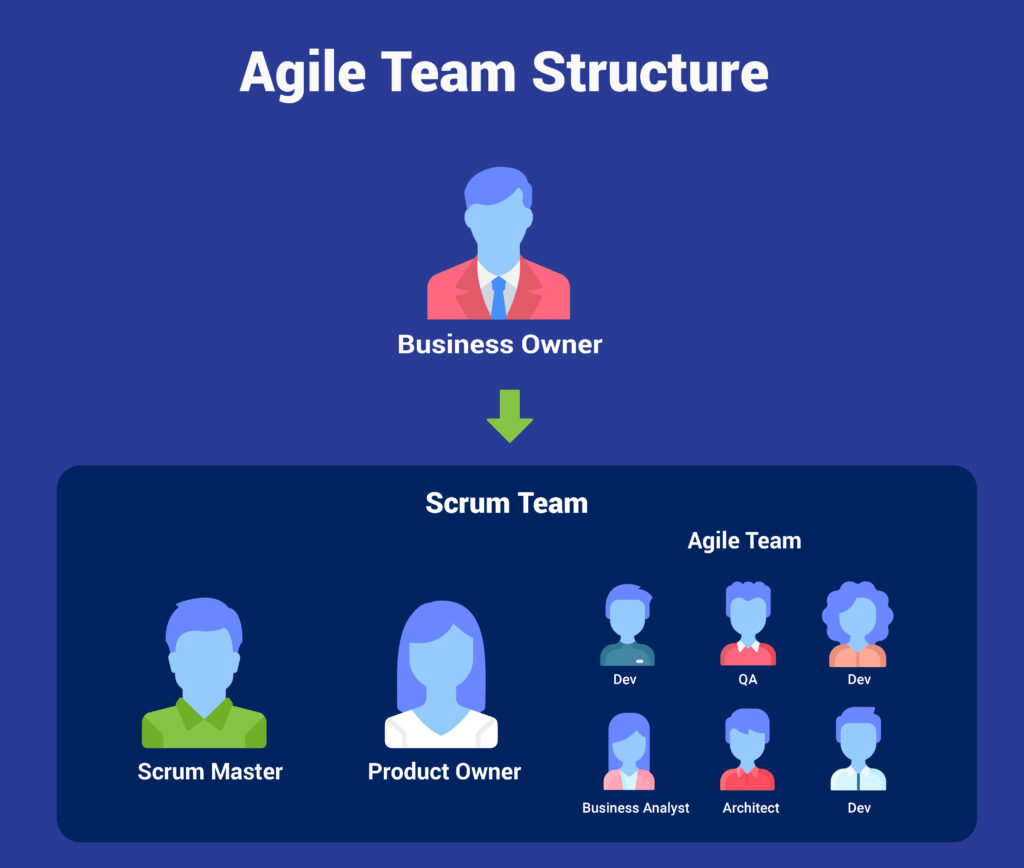How to build a Scrum team structure for agile development
Published

As the pace of business continues to accelerate, more companies are turning to agile methodologies to keep up.
And with core business revolves around meeting customer needs, reducing time to market, and reducing cycle time, the Scrum team structure has become the obvious answer for many companies.
Below we will explain what Scrum is and how you can build an effective Scrum team for agile development.
What is a Scrum Team?

Those : slideteam.net
Scrum is an iterative project management framework for implementing the agile methodology. The Scrum framework focuses on continuous improvement and learning to promote an agile mindset and enable teams to collaborate in developing projects.
With just a few rules, the Scrum framework provides a flexible guide that teams can follow and adapt to their specific projects and development environments. This flexibility makes it an attractive structure for all teams and organizations.
The basic Scrum framework consists of the following elements:
- 3 agile Scrum team roles: Product Owner, Scrum Master and Development Team
- A prioritized backlog of user requirements
- Sprints
- Scrum events
Scrum events include sprint planning meetings, daily scrum meetings, sprint review meetings, and sprint retrospectives.
Scrum team composition
The typical size of a Scrum team is five to nine people (with seven being ideal - one Product Owner , a Scrum Master and five developers).
In contrast to traditional development structures, there is no structural hierarchy in Scrum teams. Instead, they are self-managed and cross-functional. All team members are equally important and collectively have all the skills and knowledge necessary to deliver a working product.
Although everyone is equal, there are three different roles within the Scrum team structure.
Product Owner
The Product Owner is the master of the product and the basis for its success. His main role is to understand business and customer needs and define and prioritize work accordingly.
This role includes the following:
- Creation and management of the product backlog
- Communicate with the company and team to ensure everyone is on the same page
- Guide the team in selecting the next features to deliver
- Decide when the product should be delivered
In other words, the product owner acts as a guide for the team throughout the entire development process. While all team members collaborate and discuss how to approach the work, the Product Owner has the final say on what to prioritize and when.
Scrum-Master
The Scrum Master helps the team to successfully apply the Scrum framework. He keeps the team running smoothly by being overconfident Product Owner keeps the team in check, minimizes distractions and coaches them on best practices.
The Scrum Master also leads the daily Scrum meeting, which helps the team adhere to the tasks and processes.
Development team
The developers are the foundation of the Scrum team. While the Product Owner sets the priorities and the Scrum Master oversees the process, the Development Team is responsible for determining how the work should be done.
They are essentially autonomous (one of the characteristics that sets Scrum apart from other methodologies). This characteristic makes Scrum teams highly collaborative and tight-knit, often resulting in higher morale, satisfaction, and goal-setting.
Advantages of an agile team structure

Those : mitrais.com
The Scrum team structure is a popular approach for many teams - and for good reason. Scrum has several advantages:
1. Shorter feedback cycles
Because of their incremental approach to development, Scrum teams can receive and respond to feedback more quickly.
For example, instead of spending six months developing and then releasing a product based on the original requirements, Scrum teams shorten the development cycle through multiple, shorter releases (often within a few weeks).
This structure allows them to receive feedback earlier in the development process and adapt the product based on lessons learned and user feedback.
2. Greater ability to adapt to change
Scrum teams are designed to expect and adapt to change. Agile frameworks like Scrum make it easy for teams to pivot based on user feedback and changing requirements as they arise - rather than allowing these changes to interrupt or derail the development process.
3. Higher quality of products
Because Scrum teams work in an agile manner, they can deliver higher quality products with greater consistency. In addition to accepting and adjusting incremental feedback, Scrum teams also test the product every sprint to ensure issues are identified and addressed as they arise.
4. Transparency
Transparency and communication are key principles of the Scrum framework. The product owner and stakeholders take an active role in the development process.
thats why Transparency for both internal collaboration critical within the team as well as for external communication with the customer (or user) so that the work is always consistent with the product goals and requirements.
5. Higher user satisfaction
With higher quality deliverables, responsive feedback loops, clear communication, and manageable scope of work, it's no wonder Scrum teams so often experience higher user satisfaction.
6. Common team goal
The culture of Scrum is a culture of collaboration. The heart of the Scrum team are the developers. Because there is no traditional hierarchy with a team leader and the work itself is structured collaboratively, members have a shared sense of ownership of the product.
This sense of ownership improves morale, gives the team purpose, and helps everyone more productive to work.
When should you use a Scrum team structure?
Scrum teams can work on all types of software development projects, including full software packages, customer or internal work. While Scrum is a flexible and valuable approach for many types of projects, there are a few ways to recognize when it is best used.
If the requirements are not clearly defined
Sometimes customers have a general vision for their product but no clear requirements. This can make it difficult to estimate the time and cost required for fixed-cost projects or more traditional methods.
The Scrum framework is designed to adapt to changing needs, making it a natural choice for projects of indeterminate scope.
If changes are expected during development
Scrum is also particularly suitable for projects where changes are expected during development. This can be the case even if the requirements are clearly defined from the start.
For example, changes in the business environment or evolving technologies can Product requirements influence in the middle of the project. Scrum's agile structure makes it easy to accommodate changes during the development process.
If the project is complex
Complex problems are difficult to solve effectively and efficiently using traditional development methods. The more complex the project, the more problems can arise during the process.
Scrum works well for complex projects because it breaks them down iteratively and incrementally. Instead of trying to anticipate all requirements in a single plan at the beginning of the project, Scrum teams work on it piece by piece, adapting as they learn.
Choosing the right people for your Scrum team

Those : slingshotapp.io
To build a successful Scrum team, you need to bring the right people together. But what should you pay attention to?
A good Scrum team is:
- Collectively responsible for the work
- Independent and self-organizing
- Cross-functional and balanced
- Combined and everyone works together full time
Additionally, look for a product owner who is fully available to the project. He needs to be fully involved to ensure the team is setting the right priorities and addressing needs along the way.
Once you've identified the key skills required for a specific project, consider using a visual workspace to highlight employees with the required strengths and skills. In Lucidchart, you can create an org chart from employee data, add conditional formatting, and group employees based on various factors.
Although Scrum is not difficult to implement, consistently delivering real value is never easy. Teams that want to be successful in an agile environment must be committed to the process and their own personal and collective growth. Those who do this will always be one step ahead of the curve.







